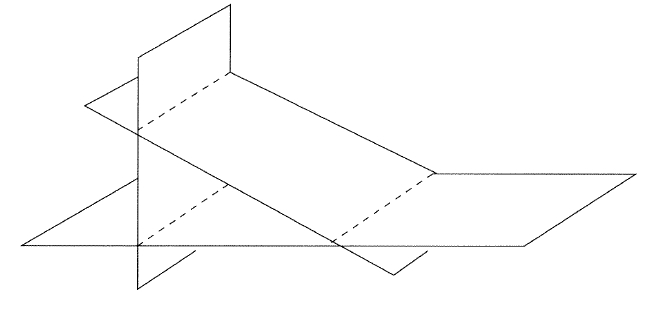Note this is Maple notation - each row of the matrix is in brackets.
Eliminate the number 3 using Gaussian elimination. Which of the following are true:
a) The Gaussian reduced matrix is Matrix([[1,h,4],[0,6-3h,-4]])
b) The system is consistent for all h
c) The system is inconsistent for h=2
d) a) and b)
e) a) and c)
1 0 0 2
0 1 0 3
0 0 1 4
a) (2,3,4)
b) (1,1,1)
c) There are an infinite number of solutions
d) There are no solutions
e) We can't tell without having the system of equations
a) at least 2 of the planes parallel
b) a missing pivot for some x_i
c) some row in the reduced augmented matrix is [0 0 0 nonzero]
d) more than one of the above
e) none of the above
a) 0 or 1
b) 0, 1, or 2
c) 0, 1, 2 or infinite
d) 0, 1, infinite
e) any number of solutions is possible

a)lies inside of R2, the x-y plane.
b)shows 3 linear equations that have 3 lines as the solutions
c)shows that 3 non-parallel planes do not have to have any points in common
d)more than one of the above choices are possible
a) A line in R2
b) A line in R3
c) A plane in R3
d) A volume in R3
a) At least two of the equations represent the same plane.
b) The three planes intersect along a line.
c) The planes represented are parallel.
d) More than one of the above choices are possible.
e) None of the above
1 1 0 2
2 1 3 3
2 2 h 4
Which of the following are true?
a) it takes at least 3 elementary row operations to get to Gaussian here
b) from Gaussian we can see that we have full pivots for all h
c) from Gaussian we can see that some h give us no solutions
d) more than one of the above is true
e) none of the above
a) I am only allowed to use the book, my group members, the math lab and Dr. Sarah for help on the problem set.
b) I can use any source for help, but the work and explanations must be distinguished as originating from my own group and I must acknowledge any help outside the group or Dr. Sarah, like "the idea for problem 1 came from discussions with johnny or this website..."
a) I must print out all work, including Maple ReducedRowEchelonForm commands and output
b) I must annotate/explain my methods and reasoning with handwritten comments and/or typed comments.
c) both a) and b)
d) neither a) nor b)